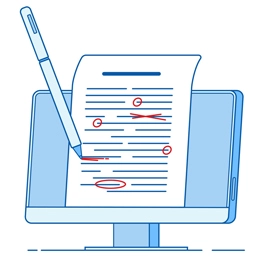
Reports
I notice that you use plain, simple language, short words, and brief sentences. That is the way to write English — it is the modern way and the best way.
– Mark Twain
Introduction
When a firm has to make a decision based on accurate information, it can prepare a business report to guide its leaders through the decision-making process. Business reports make use of facts and research in order to analyze data, evaluate performance, and present recommendations for the future of a company.
Documentation is important in business. Sometimes documentation is the only way supervisors can monitor the company’s quality of work. At other times, documentation is the key to spotting best and worst practices.
In this lesson, we will discuss the basic structure of reports, how to choose the right format, and tips on writing reports.

The fundamentals of writing a report for a business.
Reports for businesses are always written in a formal manner and are intended to be objective. Whether the report focuses on a particular circumstance or analyzes the overall performance of an entire company, every fact contained within it must be understandable and capable of being independently confirmed.
Avoid using subjective descriptions that direct the reader’s emotions in a business report, as this undermines the need of maintaining objectivity. If sales were down during the previous quarter, for example, you shouldn’t say something like “Sales were bad during the previous quarter.” Instead, you should let the sales statistics speak for itself. In addition, no personal pronouns should be used at any point in the writing, such as in the sentence “I believe we should invest more capital.” A business report ought to be objective and written from the point of view of the organization at all times.
The organizational framework of a business report
We have provided a common and reliable structure below, despite the fact that this structure can vary based on the length of the report or the standards of the company:
Front matter: Include your full name, work title, contact information, and the date the contribution was made in the “front matter.” In addition to this, you are able to give the report a title.
Context: Outline the historical context of the matter that will be the focus of your discussion, as well as the objective of the report itself.
Key findings: It would be helpful if you could provide the backdrop purpose with supporting evidence in the form of facts, data, and major results. Be as detailed and precise as possible, in particular considering that the rest of the report is dependent on the material in this area.
Conclusion: In the conclusion, you should include a synopsis of the most important findings, together with an interpretation of those findings, as well as answers to any concerns that were raised by the objective of the study.
Recommendations: Make suggestions for resolving any issues that were brought up in the conclusion, and provide a brief synopsis of how these solutions might operate. Although you are presenting your own opinion in this area, you should avoid using personal pronouns and instead make sure that everything is presented through the perspective of the firm.
References: Please provide a list of all the sources from which you obtained the information that is cited throughout the report. People are then able to discover where you received your knowledge from and conduct their own research using the same sources.
After the front matter part comes the executive summary, which is a comprehensive summary of the report that covers the study’s history, the most important results, and the recommendations. This may be required by some companies. People may rapidly learn the highlights by reading this part, which saves them from having to read the complete document. Depending on the overall length of the report, the length of an executive summary might range anywhere from a single paragraph to many pages.
Brief check
The structure is always crucial because it allows readers to simply traverse the document. The length of a report can range anywhere from one page to one hundred, but this does not change the importance of structure.
Revision
When it comes to developing a useful document, revision is essential. Review your work to ensure that it is well-focused, devoid of mistakes in proofreading and that the material you have presented is accurate and presented in an objective manner. Before you hand in your work, it is strongly suggested that you receive input from a colleague, as they may be able to discover faults that you have overlooked as well as uncover fresh chances for analysis or debate.

After you have finished revising the report’s content, you should think about how it will look. To give your work a more polished look, you might want to think about making your front matter section into a cover page. In the event that the report is particularly extensive, you may also build a table of contents. If you plan on printing it out, make sure to use good paper and either a folder or a binder to keep the report organized and in one place.

The Basic Structure
Business reports are used to provide documentation — a written record — of a topic, project, or process.
The following are the basic parts of a business report:
- Overview
- Background/ Project Scope
- Main Body
- Conclusions
The main body section of the report contains all of the details of the project or topic, including facts, methods, data, calculations, results, and interpretation. Depending on what type of report you are writing, the conclusion section provides the final result, recommendation, proposal, or concluding judgment of the report’s authors.
Brief check
Try presenting your data in a variety of formats, such as bulleted lists, visuals, and charts, to provide some variety.
Choosing a Format
As with the other business documents, such as the business proposal and the business letter, the format and length of business reports vary depending on the situation.
Be guided by the:
- The purpose of the report
- The seniority of your readers
- Your readers’ technical knowledge
- The scale of the project
- Standard protocol in your company

NOTE: The rationale behind the above criteria is similar to how the same criteria had been explained in previous modules.
Writing the Report
The following are some tips in writing a business report.
- Keep the purpose of the report in mind when writing your report.
Ask the person who requested the reports what they are expecting to see in the report and how they plan to use your documentation. This information can guide you in discerning what data to include in the report.
- Stick to objective data, unless there is a section for personal opinions.
Reports are meant to be fact-based and impartial; it’s not written so that you can present the company’s performance in the best possible light. It is only when a report is accurate can the report is truly useful. Therefore, make sure that you double-check your content. Watch if you have biases coming through on paper. If your opinions are solicited, stick to giving professional opinions substantiated by facts.
- Write to your audience.
Know who you are writing to, and determine how best to address this audience. Define the tone, attitude, and emphasis that are geared towards your readers.

Conclusion
Although the writer does offer some of his or her own commentary on the most important facts in the report’s conclusion, the bulk of the content is still written from the point of view of the business. The recommendations are understandable and are backed up by the statistics, while the references are extremely comprehensive.
Although writing business reports could make you feel anxious at first, with some practice and extensive preparation, you can produce a document that is exhaustive and full of useful information. You may assist your company in making decisions that are well-informed by gathering the facts, organizing them objectively, and presenting them to management.
Practical Application
Karen was assigned a report that she needed to write for the CEO. When she was given the assignment, the first thing she did was ask for more details on the specifications of the report. Since the report was intended for the CEO, it needed to have details that would be important to the CEO. She requested for additional details on the specifics of the report.
Karen made certain to keep it completely factual and objective, omitting any personal views that she may have had regarding the topic in question. She was prepared with an opening statement, a body that she populated with the data and figures, and a conclusion statement.
The company’s chief executive officer expressed his satisfaction with the report, and she was able to assist both him and the business.





